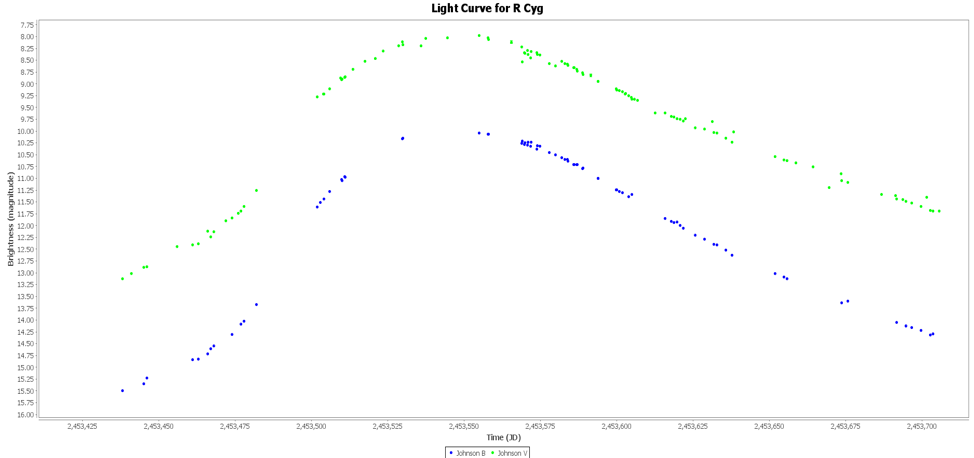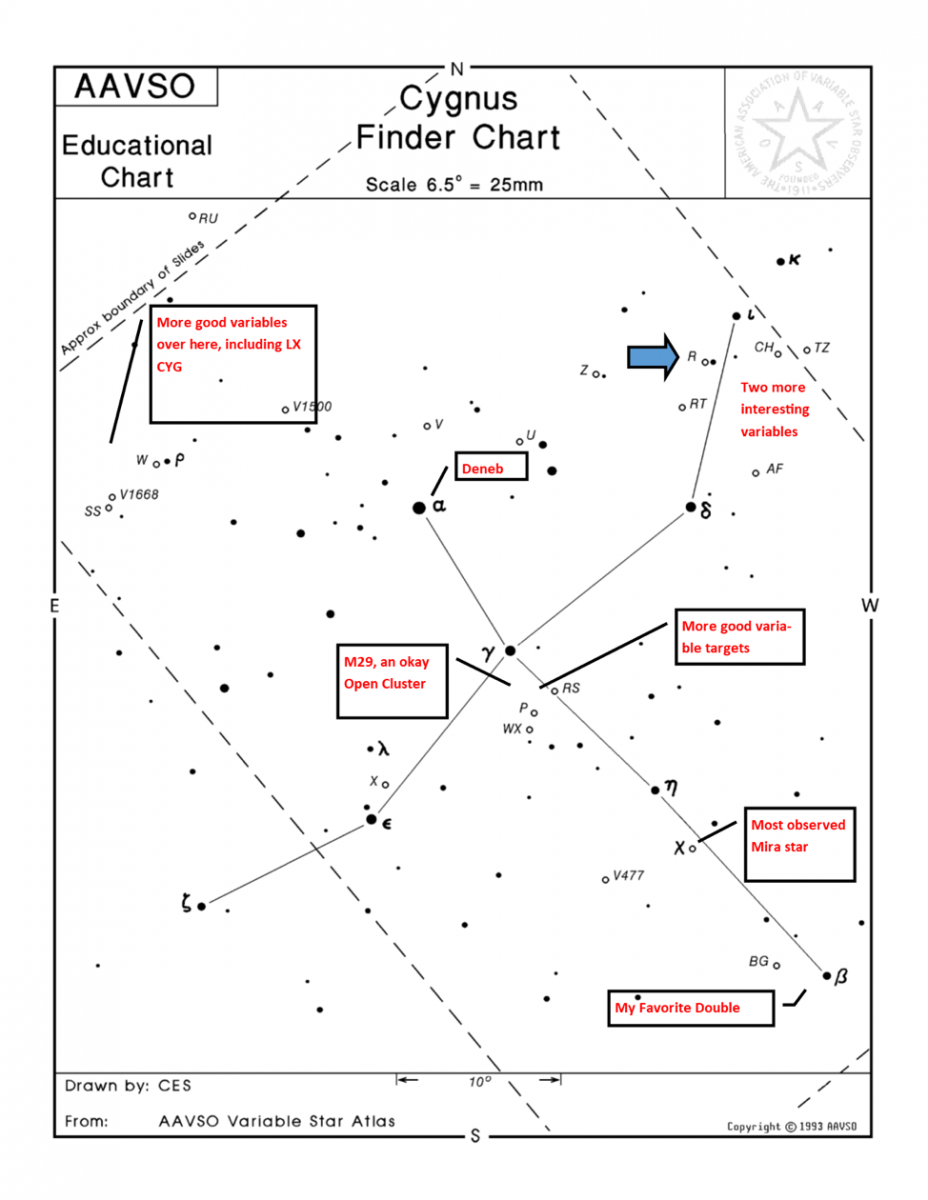R Cygni
By Rich Roberts
I keep a running log of interesting stars I plan to write about; however, R Cygni was not on my list. Many potential reasons exist for such a negligent oversight on my part. For one, numerous fascinating variables call Cygnus home, which could explain why it was overlooked. Secondly, prime Cygnus viewing in the coastal tidewater of Virginia coincides with peak humidity and peak mosquitos. My love of variables keeps me out there; however, observing is not particularly pleasant when your body is drenched in equal parts sweat and insect repellent. Cygnus is work, not fun. So, R CYG fell through the cracks and was ignored. I was debating between two stars in Hercules to write about when things changed. I received an email asking for more information about last month’s LPV of the month, which also suggested I write about R CYG. This led me to recall other email correspondence where other observers expressed their affection towards this particular variable. Intrigued, I jumped onto SIMBAD and found plenty of research and that the aforementioned email came from the lead author on several of those papers. Clearly, I had missed a worthy star. I ended my “which star in Hercules” debate in order to remedy my indefensible neglect of R CYG.
R CYG ranks as the 9th most observed Mira in VSX, with 64,871 total observations. Again, I am delinquent having only observed this star six times. I plan to right this dreadful wrong with the upcoming observing season. The first recorded observation dates all the way back to 1852 and R CYG has enjoyed good regular coverage by AAVSO observers since 1921. Almost all the observations are visual. The top three observers for this star are Frank Vohla (1,029 observations), Warren Morrison (1,004 observations), and Gunther Krisch (965 observations). The top 20 contributors are mostly from Germany, Netherlands, Canada, and Great Britain. I guess my fellow Americans are as dissuaded by the humidity and mosquitos as I am.
R Cygni belongs to an interesting stellar class known as S-type star. S-stars are fairly rare. Only 158 S-class Miras, 146 S-class Semi-regulars, and 65 Irregular S-type LPVs are found in VSX. Asymptotic Giant Branch (AGB) stars with an S-type spectral classification are thought (although not confirmed) to be an evolutionary step between the oxygen-rich (M-class) AGBs and carbon stars (C-Class). I had long thought the trademark of an S-type star is a carbon to oxygen ratio of 1. This reasoning follows the evolutionary sequence of an M-class AGB star with a C/O ratio of less than 1, and greater than 1 for a carbon star; however, things are much more complicated (and interesting!) than that.
S-stars exhibit unique nuclear chemistries which are responsible for their spectra. Although S-stars do have C/O ratios close to one, their defining characteristic is the presence of Zirconium Oxide (ZrO), as well as other s-process elements like technetium (Tc). ZrO travels a long road to find itself in the stellar atmosphere. In the boundary between the AGB star’s Hydrogen and Helium shells, Carbon-12 is converted into Carbon-13 by proton capture. This allows the important 13C(,n)16O reaction to take place, which produces numerous free neutrons. Starting with iron, several neutron capture events then take place to produce the s-process elements, such as ZrO and Tc. These heavy elements are then transported to the stellar atmosphere during thermal pulses. R CYG is considered a “pure” S-star because Titanium Oxide (TiO), the defining molecule of Mira stars, is not present in the spectra.
S-stars have stellar winds comparable to M-stars. Stellar winds tend to really start increasing when they reach the C-class stage, which may again be an indicator of an M to S to C evolutionary sequence along the AGB. However, the S-Class stars with the strongest stellar winds may already be close to the end of the AGB and may never become carbon rich. R CYG is losing approximately 9x10-7 solar masses per year, or the equivalent of three Martian masses, which is in line with the expected results for this type of star. The median stellar wind for an S-Class star is about 7.5 km/s, and is about 11 km/s for a carbon star. R CYG’s was measured at 9.5 km/s. The circumstellar environments of these stars are also conducive to MASERs, especially SiO, H2O, and OH. R CYG produces a SiO MASER.
When you examine R CYG’s light curve, the alternating brightness of its maximums is apparent. My research to date has not uncovered a likely cause. Maximum brightness has been as high as 6.2 and as low as 9.9. The minimums alternate in brightness as well, but to a much lesser degree than the maximums, anywhere from 13.2 to 14.5. Below are the last 10 cycles on visual observations and Johnson V.

And the last 1,000 days from ASAS-SN:

Wallerstein et al. (1985) examined R CYG’s spectrum during the low maximum of 1983. The first figure from this paper demonstrates the range the maximums can have as he places the highest recorded max at the time, 6.2 in 1975, next to the lowest recorded max, 9.9 in 1983.

Wallerstein also plotted out the maximums vs time using AAVSO data from 1921 to 1983 and found a linear but inverse relationship between the maximum brightness and the interval from the previous max.

Due to the lack of multiband photometry in the AID, I did not plot out B-V over time to look for changes. Below is a cycle of Johnson V and Johnson B from 2005. The magnitude widening between the two bands is evident as you compare the light curve at minimum light vs maximum light.

VSX lists R CYG’s period at 426.45 days, which is similar to what I found via Discrete Fourier analysis in VSTAR.

This period produced a good phase plot in the last 1,000 days of ASAN-SN data. The phase plot with this period also produced a sufficient phase plot from AAVSO visual and Johnson V data from 1921 to present, which indicates the period has been relatively stable for a long time.


When looking at the long-term AAVSO data phase plot, the striking feature is the amplitude range the star can exhibit at the same point in its cycle, yet that periodicity is very consistent. Mira stars are known to have cycle to cycle variation in period and amplitude, which suggest non-linear behavior. The possibility of low dimension chaos in R CYG was studied by Kiss and Szatmary (2002), but the results were not conclusive. Templeton et al. (2005) examined 547 different Mira stars to identify those with large changes in period changes and found R CYG was a star not exhibiting such behavior. There is some cycle to cycle period changes (about 2.5% variance from the mean) as shown in the plot below, but they are not statistically significant.

Semi-amplitude also shows some variance over time, with a range as high as 3 and a low of 2.75, which again is not uncommon in this type of star.
If you still need more convincing in order to brave oppressive heat, humidity, and mosquitos, remember that R CYG is in a good neighborhood with many other interesting variables nearby. RT CYG, Z CYG, CH CYG, and AF CYG are all within a few degrees in the Swan’s left wing. You can then head towards Cyg with a quick detour to the unspectacular open cluster M29 before observing P CYG and RS CYG (https://www.aavso.org/lpv-month-january-2017). You can then move down the Swan’s neck to catch up with the most observed Mira in the AID, CYG (https://www.aavso.org/lpv-month-january-2018). Another LPV Program star, BG CYG, is also in the area, not to mention one of my other guilty pleasures, Albireo.

R CYG is an interesting star which warrants continued monitoring by AAVSO observers. The star has a unique and well-developed light curve which spans 150 years and occupies a unique place in stellar evolution. The continued monitoring of stars like R CYG may be the key to better understanding the stellar evolutionary processes along the AGB. R CYG has a good sequence for quality estimates and is accessible to those binoculars and small scopes at the top of its light curve. R CYG also maintains an interesting chemistry, and stars like it play a crucial role in developing the heavy elements needed for planets and life. I was dismayed to find no entries for R CYG in the AAVSO spectral database. Hopeful someone with those capabilities will remedy this! I also hope more observers will reach out with interesting targets so other worthy stars do not get slighted and feel unloved.
References



